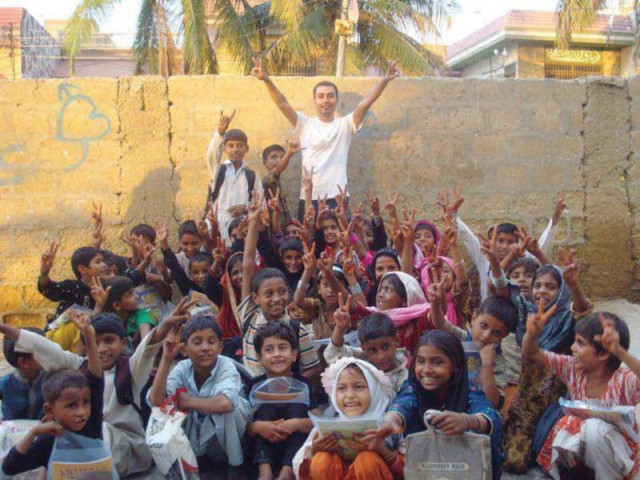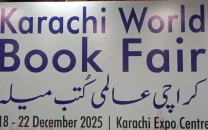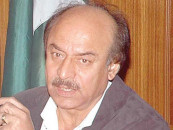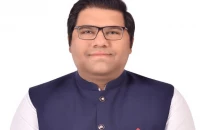Education for all: I have a dream
Syed Fahad Ali runs the Aghaaz School all on his own in Gulshan-e-Iqbal

Syed Fahad Ali poses with his students. He runs the Aghaaz School entirely on his own in Gulshan-e-Iqbal, which has 60 per cent girls in a total enrolment of 124 students. PHOTO: COURTESY SYED FAHAD ALI
Syed Fahad Ali, a passionate young man running the Aghaaz School entirely on his own in a small neighbourhood in Gulshan-e-Iqbal, has only one rule: if someone wants to enrol their boys in his school, they have to get their girls enrolled as well.
"I have made it mandatory in my school that if anyone wishes to get their boys enrolled, they have to get their girls admitted as well," says Ali. For him, opening a school that provided free education to children had been a dream he had fostered while studying in a government school. "There is a definitive issue with attitudes when it comes to girls' education," he says. "I simply don't take male students unless the parents come forward and get their girls enrolled too."

Perhaps it is due to Ali's principled stance that Aghaaz School has 60 per cent girls in a total enrolment of 124 students. The standing structure that is based on six classrooms and a kitchen has students divided into six different learning levels, culminating at grade three. The curriculum accommodates the usual courses of formal learning, such as Urdu, English, Science, Islamiat, Social Studies and nutrition programmes among others. A security deposit of Rs500 is taken for each student, which is returned at the end of the year.
Read: Education for all: ‘Aao Parhao to focus on adult literacy in DG Khan’
The children enrolled at the school belong to the nearby goths. According to Ali, these include children of drug addicts, those from families afflicted with domestic violence and daily wage earners who make less than Rs100 a day. "You can see their familial upbringing in the way students carry themselves," he explains. "For instance, the child of a drug addict walks with his arms flagging by the sides while another, who has witnessed domestic violence as a norm in his house, wears a dominant, aggressive attitude. Problems like these remain our concern throughout the time children stay with us. We have teachers with background in psychology to deal with this [kind of issues]."
It was in the year, 2011, when Ali started giving lessons in an enclosed 15x10 space in a slum with 70 students on board. Apart from issues of insufficient place, curriculum and teachers, Ali faced problems characteristic to the city's ethnic conflicts. The situation rose to a point that a Pathan child would not sit next to a Punjabi and vice versa, with violent elements making it difficult for his school to function normally. "This was not it," says Ali. "Upon moving to another location in a nearby goth, the existing school with its huge fancy building would throw trash on our way even when we had no comparison to them."
Read: Education for all: For Pakistan, still a long road ahead
As someone who shifted from a private school to a public one in his formative years, Ali sees the contrasting parallels in both the systems. He believes that students of government schools suffer the most due to ineffective teacher-student relationship while the student-to-teacher ratio is not an impediment at all. "It's all a big lie and a means to cover up their failings," he says. "If a single teacher can handle a few, he can handle a hundred, too. Teachers don't have empathy. That's where the problem lies."
Published in The Express Tribune, September 23rd, 2015.



















COMMENTS
Comments are moderated and generally will be posted if they are on-topic and not abusive.
For more information, please see our Comments FAQ